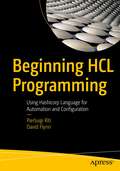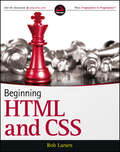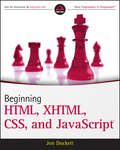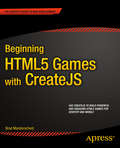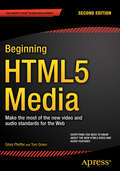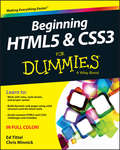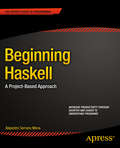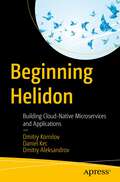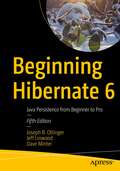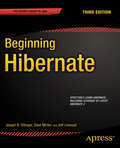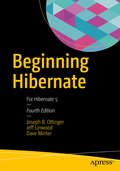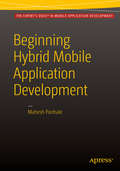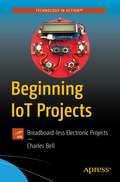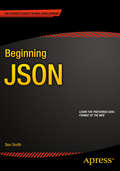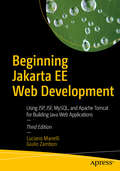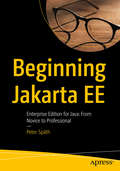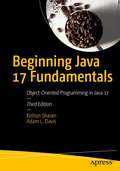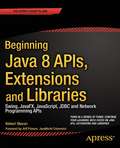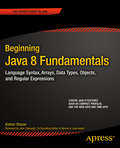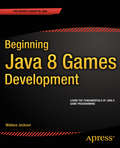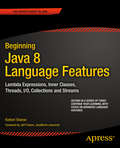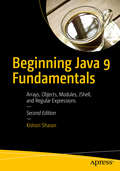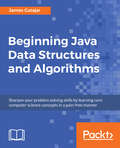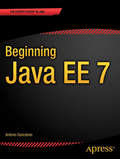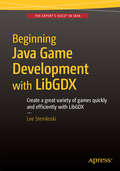- Table View
- List View
Beginning HCL Programming: Using Hashicorp Language for Automation and Configuration
by Pierluigi Riti David FlynnGet started with programming and using the Hashicorp Language (HCL). This book introduces you to the HCL syntax and its ecosystem then it shows you how to integrate it as part of an overall DevOps approach. Next, you’ll learn how to implement infrastructure as code, specifically, using the Terraform template, a set of cloud infrastructure automation tools. As part of this discussion, you’ll cover Consul, a service mesh solution providing a full-featured control plane with service discovery, configuration, and segmentation functionality. You’ll integrate these with Vault to build HCL-based infrastructure as code solutions. Finally, you’ll use Jenkins and HCL to provision and maintain the infrastructure as code system. After reading and using Beginning HCL Programming, you'll have the know-how and source code to get started with flexible HCL for all your cloud and DevOps needs. What You Will Learn Get started with programming and using HCL Use Vault, Consul, and Terraform Apply HCL to infrastructure as code Define the Terraform template with HCL Configure Consul using HCL Use HCL to configure Vault Provision and maintain infrastructure as code using Jenkins and HCL Who This Book Is For Anyone new to HCL but who does have at least some prior programming experience as well as knowledge of DevOps in general.
Beginning HTML and CSS
by Rob LarsenEverything you need to build websites with the newest versions of HTML and CSSIf you develop websites, you know that the goal posts keep moving, especially now that your website must work on not only traditional desktops, but also on an ever-changing range of smartphones and tablets. This step-by-step book efficiently guides you through the thicket. Teaching you the very latest best practices and techniques, this practical reference walks you through how to use HTML5 and CSS3 to develop attractive, modern websites for today's multiple devices. From handling text, forms, and video, to implementing powerful JavaScript functionality, this book covers it all.Serves as the ultimate beginners guide for anyone who wants to build websites with HTML5 and CSS3, whether as a hobbyist or aspiring professional developerCovers the basics, including the different versions of HTML and CSS and how modern websites use structure and semantics to describe their contentsExplains core processes, such as marking up text, images, lists, tables, forms, audio, and videoDelves into CSS3, teaching you how to control or change the way your pages look and offer tips on how to create attractive designsExplores the jQuery library and how to implement powerful JavaScript features, such as tabbed content, image carousels, and moreGet up to speed on HTML5, CSS3, and today's website design with this practical guide. Then, keep it on your desk as a reference!
Beginning HTML, XHTML, CSS, and JavaScript®
by Jon DuckettAn indispensable introductory guide to creating web pages using the most up-to-date standards This beginner guide shows you how to use XHTML, CSS, and JavaScript to create compelling Web sites. While learning these technologies, you will discover coding practices such as writing code that works on multiple browsers including mobile devices, how to use AJAX frameworks to add interactivity to your pages, and how to ensure your pages meet accessible requirements. Packed with real-world examples, the book not only teaches you how to write Web sites using XHTML, CSS and JavaScript, but it also teaches you design principles that help you create attractive web sites and practical advice on how to make web pages more usable. In addition, special checklists and appendices review key topics and provide helpful references that re-enforce the basics you've learned. Serves as an ideal beginners guide to writing web pages using XHTML Explains how to use CSS to make pages more appealing and add interactivity to pages using JavaScript and AJAX frameworks Share advice on design principles and how to make pages more attractive and offers practical help with usability and accessibility Features checklists and appendices that review key topics This introductory guide is essential reading for getting started with using XHTML, CSS and JavaScript to create exciting and compelling Web sites. Note: CD-ROM/DVD and other supplementary materials are not included as part of eBook file.
Beginning HTML5 Games with CreateJS
by Brad ManderscheidBeginningHTML5 Games with CreateJS provides a hands-on approach to get you up and running withthe most comprehensive tools available for HTML5 Canvas game development. Whether you are brand new to making games or an experienced game developer, youOCOll learn to fully utilize the CreateJS suite to bring your new or existinggame techniques to desktop and mobile devices. Thisbook covers everything from creating graphics in HTML5 Canvas, to capturinguser input (whether from keyboard, mouse, or touch), to using a state machinefor efficient game control. There are practical (and fun) examples throughoutthe book, with four full game projects, including a mobile RPG. The book alsocovers optimizing your games for mobile and publishing them to app stores. HTML5games are growing more and more popular, and the demand for HTML5 Canvas skillsis on the rise. The CreateJS suite is a powerful toolset that will help youmanage Canvas drawing and animations, asset loading, sound management, complextweening, and much more. Using these robust libraries, you can build powerfuland engaging games that reach a wide range of audiences and devices. "
Beginning HTML5 Media: Make the most of the new video and audio standards for the Web
by Silvia Pfeiffer Tom GreenBeginning HTML5 Media, Second Edition is a comprehensive introduction to HTML5 video and audio. The HTML5 video standard enables browsers to support audio and video elements natively. This makes it very easy for web developers to publish audio and video, integrating both within the general presentation of web pages. For example, media elements can be styled using CSS (style sheets), viewed on a mobile device, and manipulated in a Canvas or an audio filter graph. The book offers techniques for providing accessibility to media elements, enabling consistent handling of alternative representations of media resources. The update includes all of the changes and revisions since the first HTML5 draft. Beginning HTML5 Media dives deep into the markup that is introduced for media element support in browsers. You'll explore the default user interface offered through browsers for media elements, as well as the JavaScript API provided to control their behavior. You'll also learn how to account for H. 264, WebM and Ogg Theora codecs as well as explore the emerging Web Audio API standard, which provides an extensive set of hardware-accelerated audio filters to achieve a level of audio signal manipulation in the browser previously only available to audio professionals. What you'll learn How to create cross-browser markup in HTML to include audio and video into your web pages How to replace the default controls of web browsers with your own or "skin" your media player How to use the JavaScript API for media elements How to integrate media elements with other HTML5 constructs such as CSS, Canvas, or Web Worker Threads How to make audio and video accessible How to use media fragment URIs to address certain temporal subparts or tracks of a media resource How to work with the Web Audio API Who this book is for This book is for those who are proficient in authoring and publishing Web pages, but have never utilized audio and video. It will also help those proficient in the use of Adobe Flash, Microsoft Silverlight, or QuickTime to understand what is happening in HTML5 media and how to use the new media elements. Table of Contents 1. Encoding Media 2. Using and Manipulating Media Elements 3. The JavaScript API 4. Accessibility and Internationalization of HTML5 Media 5. Manipulating Media via Canvas 6. Manipulating Audio Through the WebAudio API
Beginning HTML5 and CSS3 For Dummies
by Ed Tittel Chris MinnickYour full-color, friendly guide to getting started with HTML5 and CSS3!HTML and CSS are essential tools for creating dynamic websites and help make your websites even more effective and unique. This friendly-but-straightforward guide gets you started with the basics of the latest versions of HTML and CSS: HTML5 and CSS3. Introducing you to the syntax and structure of the languages, this helpful guide shows you how to create and view a web page, explains ideal usage of HTML5 and CSS3, walks you through the CSS3 rules and style sheets, addresses common mistakes and explains how to fix them, and explores interesting HTML5 tools.Serves as an ideal introduction to HTML5 and CSS3 for beginners with little to no web development experienceDetails the capabilities of HTML5 and CSS3 and how to use both to create responsive, practical, and well-designed websitesHelps you understand how HTML5 and CSS3 are the foundation upon which hundreds of millions of web pages are builtFeatures full-color illustrations to enhance your learning processBeginning HTML5 and CSS3 For Dummies is the perfect first step for getting started with the fundamentals of web development and design.
Beginning Haskell: A Project-Based Approach
by Alejandro Serrano MenaBeginning Haskell provides a broad-based introduction to the Haskell language, its libraries and environment, and to the functional programming paradigm that is fast growing in importance in the software industry. The book takes a project-based approach to learning the language that is unified around the building of a web-based storefront. Excellent coverage is given to the Haskell ecosystem and supporting tools. These include the Cabal build tool for managing projects and modules, the HUnit and QuickCheck tools for software testing, the Scotty framework for developing web applications, Persistent and Esqueleto for database access, and also parallel and distributed programming libraries. Functional programming is gathering momentum, allowing programmers to express themselves in a more concise way, reducing boilerplate and increasing the safety of code. Indeed, mainstream languages such as C# and Java are adopting features from functional programming, and from languages implementing that paradigm. Haskell is an elegant and noise-free pure functional language with a long history, having a huge number of library contributors and an active community. This makes Haskell the best tool for both learning and applying functional programming, and Beginning Haskell the perfect book to show off the language and what it can do. Takes you through a series of projects showing the different parts of the language. Provides an overview of the most important libraries and tools in the Haskell ecosystem. Teaches you how to apply functional patterns in real-world scenarios. What you'll learn Build small and large projects using the Haskell language. Profit from ecosystem tools such as Cabal, HLint, and QuickCheck. Implement efficient stream I/O via libraries like Conduit. Parallelize code to run on multiple processors or distributed across a network. Create domain-specific languages useable by business users, and to tackle specific problem domains. Build Haskell-backed websites using database and web-application libraries such as Persistent, Esqueleto, and Scotty Who this book is for Beginning Haskell is for programmers new to functional programming, who want to learn this new paradigm and how it can improve the quality of their code. Beginning Haskell is also a great choice for functional programmers wanting to get a taste of the Haskell ecosystem and its unique features, or who wish to learn about advanced type system features and patterns. Table of Contents Part I: First Steps 1. Going Functional 2. Declaring the Data Model 3. Reusing Code through Lists 4. Using Containers and Type Classes 5. Laziness and Infinite Structures Part II: Data Mining 6. Knowing Your Clients Using Monads 7. More Monads: Now for Recommendations 8. Parallelizing the Execution Part III: Resource Handling 9. Dealing with Files: IO and Conduit 10. Builders and Parsers 11. Safe Database Access 12. Web Applications Part IV: Domain Specific Languages 13. Strong Types 14. Attribute Grammars Part V: Engineering the Store 15. Documenting, Testing, and Verifying 16. Architecting Your Application Appendix A Appendix B
Beginning Helidon: Building Cloud-Native Microservices and Applications
by Dmitry Kornilov Daniel Kec Dmitry AleksandrovLearn how to build cloud-native microservices with Helidon - an open-source Java framework from Oracle. This book will show you how to take full advantage of the cloud by optimizing applications with fast start times, low memory consumption, and a small disk footprint. The open-source Helidon framework provides all that, and more. It’s based on Java 17, giving you full access to new code features. This book reveals how Helidon also supports modern enterprise Java standards such as MicroProfile. Plus, you'll see how Helidon lets you use GraalVM to build lightning-fast native executables, and its unique reactive layer allows you to develop efficient low-level APIs.Each chapter in the book teaches a new Helidon concept through practical examples based on real-life use-cases. You’ll learn how to add observability and security to your microservices, how to work with databases, and call other services. You'll also look at all MicroProfile 5.0 platform specifications as well as some stand-alone specs such as Messaging and Long Running Actions. Best of all, everything covered in this book makes it a great study guide for the upcoming Oracle Helidon certification - the perfect way to prove your new skills to a prospective employer!What You'll LearnPackage microservices using JLink and GraalVMDeploy microservices to Kubernetes Review MicroProfile 5.0 specifications in detailUnderstand the basics of Helidon Reactive APIsWho This Book Is ForDevelopers and architects who want to start developing cloud-native applications; developers who already use different Java framework and want to learn about Helidon; those interested in developing portable applications using MicroProfile and Jakarta EE
Beginning Hibernate 6: Java Persistence from Beginner to Pro
by Joseph B. Ottinger Dave Minter Jeff LinwoodGet started with Hibernate, an open source Java persistence layer and gain a clear introduction to the current standard for object-relational persistence in Java. This updated edition includes the new Hibernate 6.0 framework which covers new configuration, new object relational mapping changes, and enhanced integration with the more general Spring, Boot and Quarkus and other Java frameworks.The book keeps its focus on Hibernate without wasting time on nonessential third-party tools, so you’ll be able to immediately start building transaction-based engines and applications. Experienced authors Joseph Ottinger with Dave Minter and Jeff Linwood provide more in-depth examples than any other book for Hibernate beginners. They present their material in a lively, example-based manner—not a dry, theoretical, hard-to-read fashion.What You'll LearnBuild enterprise Java-based transaction-type applications that access complex data with HibernateWork with Hibernate 6 using a present-day build processIntegrate into the persistence life cycleSearch and query with the new version of HibernateKeep track of versioned data with Hibernate EnversWho This Book Is ForProgrammers experienced in Java with databases (the traditional, or connected, approach), but new to open-source, lightweight Hibernate.
Beginning Hibernate: An Introduction To All The New Featres Of The Hibernate 3.2 Persistense Api
by Joseph B. Ottinger Dave Minter Jeff LinwoodBeginning Hibernate, Third Edition is ideal if youOCOre experienced in Java with databases (the traditional, or OC connected, OCO approach), but new to open-source, lightweight Hibernate, a leading object-relational mapping and database-oriented application development framework. This book packs in information about the release of the Hibernate 4. x persistence layer and provides a clear introduction to the current standard for object-relational persistence in Java. And since the book keeps its focus on Hibernate without wasting time on nonessential third-party tools, youOCOll be able to immediately start building transaction-based engines and applications. Experienced authors Joseph Ottinger with Dave Minter and Jeff Linwood provide more in-depth examples than any other book for Hibernate beginners. The authors also present material in a lively, example-based mannerOConot a dry, theoretical, hard-to-read fashion. "
Beginning Hibernate: For Hibernate 5
by Joseph B. Ottinger Dave Minter Jeff LinwoodBeginning Hibernate, Second Edition is ideal if you're experienced in Java with databases (the traditional, or "connected," approach), but new to open-source, lightweight Hibernate--the de facto object-relational mapping and database-oriented application development framework. This book packs in information about the release of the Hibernate 3. 5 persistence layer and provides a clear introduction to the current standard for object-relational persistence in Java. And since the book keeps its focus on Hibernate without wasting time on nonessential third-party tools, you'll be able to immediately start building transaction-based engines and applications. Experienced authors Dave Minter and Jeff Linwood provide more in-depth examples than any other book for Hibernate beginners. The authors also present material in a lively, example-based manner--not a dry, theoretical, hard-to-read fashion. What you'll learn How to build enterprise Java-based transaction-type applications that access complex data with Hibernate, including Software as a Service (SaaS) How to work with Hibernate 3. 5 Where to integrate into the persistence lifecycle, including cloud application implications How to map using annotations, Hibernate XML files, and more How to search and query with the new version of Hibernate When to integrate with Spring, Grails, and more Who this book is for This book is for Java developers who want to learn about Hibernate. Table of Contents An Introduction to Hibernate Integrating and Configuring Hibernate Building a Simple Application The Persistence Life Cycle An Overview of Mapping Mapping with Annotations Creating Mappings with Hibernate XML Files Using the Session Searches and Queries Advanced Queries Using Criteria Filtering the Results of Searches Case Study -- Using Hibernate with an Existing Database
Beginning Hybrid Mobile Application Development
by Mahesh PanhaleToday, a mobile device user prefers installed application over browsing internet; e. g. booking cab, buying movie tickets, watching you tube videos etc. Market share of mobile devices based on android, iOS & Windows Phone is considerable. Creating an installable application targeting these multiple devices involves too much of pain because of expertise required e. g. Java for android, Objective C for iOS and DotNET for Windows Phone. Shortcomings of this development approach are - more development time, it requires different expertise & involves less reusability of the code. A solution to this problem is HTML 5, JQuery, CSS 3 based - Hybrid Mobile Applications . These hybrid applications needs to be created once but after packaging can be deployed on multiple mobile devices like Android, iOS & Windows Phone. This kind of application development has edge over native application development. Beginning Hybrid Mobile Application Development by Panhale can help each entity involved in mobile application development. With availability of multiple coding and packaging platforms; HMAD has even become more easy. Since HMAD happens in HTML & Javascript it's even possible that with small effort conditionally; existing web application can be converted into mobile based application. HMAD can give larger audience for many web applications by making it available as mobile application. This book covers: Basics of Hybrid Application Development Platforms, Frameworks used for Hybrid Application Development Internals of how hybrid applications work Hybrid Application Development using available APIs Accessing data in hybrid application Role of JSON over XML in hybrid application Code Security This book will change the paradigm of mobile application development as the efforts are less, learning curve is small, success ratio is high and monetary benefit is on higher side! What you'll learn How to create, package, test & deploy hybrid mobile application step by step How to solve issues while accessing device specific features How to establish synergy between web application & mobile application Insight to advertisement frameworks in hybrid applications How to secure code in hybrid application Who this book is for Mobile application developers for Android, iOS, Windows Phone architects, and technical managers. Table of Contents Introduction to Mobile Application Development (MAD) Getting Started Building blocks of HMAD Creating first Hybrid Application HMAD: Internals Data Access in HMAD UI for HMAD Using device specific features in HMAD How to advertise with HMAD Working with third party services in HMAD Setup and Deployment XAMARIN vs HMAD! Case Study: Practical Approach
Beginning IoT Projects: Breadboard-less Electronic Projects
by Charles BellExperiment with building IoT projects without the demanding time or patience required to learn about electronics. This book thoroughly introduces readers of all ages to the world of IoT devices and electronics without getting bogged down by the overly technical aspects or being tied to a specific platform. You'll learn IoT, Arduino, Raspberry Pi from the ground up using the Qwiic and Grove components systems. The book begins with a brief overview of IoT followed by primers for the two most popular platforms; Arduino and Raspberry Pi. There is also a short tutorial on programming each host; Arduino C-like sketches and Python scripts respectfully. Thus, the book also helps you get started with your choice of platform. Next, you’ll learn the basics for the Qwiic and Grove component systems.The rest of the book presents a number of projects organized into easy-to-follow chapters that details the goal for the project, the components used, a walk-through of the code, and a challenge section that provides suggestions on how to improve or augment the project. Projects are presented for both the Arduino and Raspberry Pi where possible making each project as versatile as possible.What You'll LearnWrite Arduino sketchesCreate Python scripts for the Raspberry PiBuild IoT projects with Arduino and Raspberry PiUse the Qwiic and Grove component systemsJoin the electronics and IoT hobby world with almost no experienceHost projects data in the cloud using ThingSpeakWho This Book Is ForThose interested in building or experimenting with IoT solutions but have little or no experience working with electronics. This includes those with little or no programming experience. A secondary target would include readers interested in teaching the basics of working with Arduino and Raspberry Pi to others.
Beginning JSON
by Ben SmithBeginning JSON is the definitive guide to JSON - JavaScript Object Notation - today's standard in data formatting for the web. The book starts with the basics, and walks you through all aspects of using the JSON format. Beginning JSON covers all areas of JSON from the basics of data formats to creating your own server to store and retrieve persistent data. Beginning JSON provides you with the skill set required for reading and writing properly validated JSON data. The first two chapters of the book will discuss the foundations of JavaScript for those who need it, and provide the necessary understandings for later chapters. Chapters 3 through 12 will uncover what data is, how to convert that data into a transmittable/storable format, how to use AJAX to send and receive JSON, and, lastly, how to reassemble that data back into a proper JavaScript object to be used by your program. The final chapters put everything you learned into practice.
Beginning Jakarta EE Web Development: Using JSP, JSF, MySQL, and Apache Tomcat for Building Java Web Applications
by Giulio Zambon Luciano ManelliStart building Java-based web applications now, even if you’re a complete newcomer to Java. Comprehensive and example-driven, this book is all you need to develop dynamic Java-based web applications using JSP, connect to databases with JSF, and put them into action using the popular open source Java web server, Apache Tomcat.Beginning Jakarta EE Web Development is a comprehensive introduction to building Java-based web applications using JSP, JSF, MySQL, and the Apache Tomcat web application server. Other APIs including JSON, JSTL, and XML parser are covered along the way.Key concepts are made easy to grasp with numerous working examples and a walk-through of the development of a complete ecommerce project. This book is written for professionals by practicing Java web application professionals and experts. What You Will LearnBuild Java-based web applications using JSP and JSF with Eclipse Jakarta EEConfigure your database with MySQLDefine XML documents for your applicationsUse the Apache MyFaces APIs to create JSF applicationsIntegrate and implement JSF and JSP togetherBuild an online ecommerce web application Who This Book Is ForProgrammers new to programming in Java and programming in general.
Beginning Jakarta EE: Enterprise Edition for Java: From Novice to Professional
by Peter SpäthBuild Java-based enterprise applications using the open source Eclipse Jakarta EE platform. This feature-packed book teaches you enterprise Java development top to bottom. It covers Java web-tier development using servlets, JavaServer Faces (JSF), RESTful applications, and JSON. You’ll also cover Java data-tier development using persistence and transaction handling, messaging services, remote procedure calls, concurrency, and security to round out a complete Java-based enterprise application.Step by step and easy to follow, Beginning Jakarta EE includes many practical examples. Written by a Java expert and consultant, this book contains the best information possible on enterprise Java technologies. You’ll see that Jakarta EE is the next evolution of Java EE 8 and how it is one of the leading Java platforms for enterprise application development. What You Will LearnBuild enterprise Java applications using Jakarta EESet up your development environmentCreate page-flow web applications with JSF Write single-page web applications with REST and JSONPersist data using JPA in Jakarta EEBuild enterprise Java modules using EJBs and CDI Work with transaction engines using JTA Secure, log, and monitor your Jakarta EE applications Who This Book Is ForBeginning Java EE application developers with some experience of Java 8.
Beginning Java 17 Fundamentals: Object-Oriented Programming in Java 17
by Adam L. Davis Kishori SharanLearn the fundamentals of the Java 17 LTS or Java Standard Edition version 17 Long Term Support release, including basic programming concepts and the object-oriented fundamentals necessary at all levels of Java development. Authors Kishori Sharan and Adam L. Davis walk you through writing your first Java program step-by-step. Armed with that practical experience, you'll be ready to learn the core of the Java language. Beginning Java 17 Fundamentals provides over 90 diagrams and 240 complete programs to help you learn the topics faster. While this book teaches you the basics, it also has been revised to include the latest from Java 17 including the following: value types (records), immutable objects with an efficient memory layout; local variable type inference (var); pattern matching, a mechanism for testing and deconstructing values; sealed types, a mechanism for declaring all possible subclasses of a class; multiline text values; and switch expressions. The book continues with a series of foundation topics, including using data types, working with operators, and writing statements in Java. These basics lead onto the heart of the Java language: object-oriented programming. By learning topics such as classes, objects, interfaces, and inheritance you'll have a good understanding of Java's object-oriented model. The final collection of topics takes what you've learned and turns you into a real Java programmer. You'll see how to take the power of object-oriented programming and write programs that can handle errors and exceptions, process strings and dates, format data, and work with arrays to manipulate data. What You Will LearnWrite your first Java programs with emphasis on learning object-oriented programmingHow to work with switch expressions, value types (records), local variable type inference, pattern matching switch and more from Java 17Handle exceptions, assertions, strings and dates, and object formattingLearn about how to define and use modulesDive in depth into classes, interfaces, and inheritance in JavaUse regular expressionsTake advantage of the JShell REPL tool Who This Book Is For Those who are new to Java programming, who may have some or even no prior programming experience.
Beginning Java 8 APIs, Extensions and Libraries: Swing, JavaFX, JavaScript, JDBC and Network Programming APIs
by Kishori SharanBeginning Java 8 APIs, Extensions and Libraries completes the Apress Java learning journey and is a comprehensive approach to learning the Java Swing, JavaFX, Java Scripting, JDBC and network programming APIs. This book covers the key extesnsions of the Java programming language such as Swing, JavaFX, network programming, and JDBC. Each topic starts with a discussion of the topic's background. A step-by-step process, with small snippets of Java code, provides easy-to-follow instructions. At the end of a topic, a complete and ready-to-run Java program is provided. This book contains over 130 images and diagrams to help you visualize and better understand the topics. More than 130 complete programs allow you to practice and quickly learn the topics. The Swing chapters discuss various aspects of working with a GUI, from the very basic concepts of developing a Swing application, to the most advanced topics, such as decorating a Swing component with a JLayer, drag-and-drop features, Synth Skinnable L&F, etc. The chapter on network programming covers the basics of network technologies first, and then, the advanced topics of network programming, using a Java class library. It covers IPv4 and IPv6, addressing schemes, subnetting, supernetting, multicasting, TCP/IP sockets, UPD sockets, asynchronous socket I/O, etc. The chapter on JDBC provides the details of connecting and working with databases such as Oracle, SQL Server, MySQL, DB2, Java DB (Apache Derby), Sybase, Adaptive Server Anywhere, etc. It contains a complete discussion on processing a ResultSet and a RowSet. It discusses how to use the RowSetFactory, to obtain a RowSet object of a specific type. Working with Large Objects (LOBs), such as Blob, Clob, and NClob, is covered in detail with Java code examples and database scripts.
Beginning Java 8 Fundamentals: Language Syntax, Arrays, Data Types, Objects, and Regular Expressions
by Kishori SharanBeginning Java 8 Fundamentals provides a comprehensive approach to learning the Java programming language, especially the object-oriented fundamentals necessary at all levels of Java development. Author Kishori Sharan provides over 90 diagrams and 240 complete programs to help beginners and intermediate level programmers learn the topics faster. Starting with basic programming concepts, the author walks you through writing your first Java program step-by-step. Armed with that practical experience, you'll be ready to learn the core of the Java language. The book continues with a series of foundation topics, including using data types, working with operators, and writing statements in Java. These basics lead onto the heart of the Java language: object-oriented programming. By learning topics such as classes, objects, interfaces, and inheritance you'll have a good understanding of Java's object-oriented model. The final collection of topics takes what you've learned and turns you into a real Java programmer. You'll see how to take the power of object-oriented programming and write programs that can handle errors and exceptions, process strings and dates, format data, and work with arrays to manipulate data. What you'll learn How to write your first Java programs with an emphasis on learning object-oriented programming in Java What are data types, operators, statements, classes and objects How to do exception handling, assertions, strings and dates, and object formatting What are regular expressions and how to use them How to work with arrays, interfaces, enums, and inheritance How to deploy Java applications on memory-constrained devices using compact profiles Who this book is for This book is for those who are new to Java programming, who may have some or even no prior programming experience. Table of Contents 1. Programming Concepts 2. Writing Java Programs 3. Data Types 4. Operators 5. Statements 6. Classes and Objects 7. Object and Objects Classes 8. Wrapper Classes 9. Exception Handling 10. Assertions 11. Strings 12. Dates and Times 13. Formatting Data 14. Regular Expressions 15. Arrays 16. Inheritance 17. Interfaces 18. Enum Types 19. ASCII Character Set 20. Writing Documentation Comments 21. Compact Profiles
Beginning Java 8 Games Development
by Wallace JacksonBeginning Java 8 Games Development, written by Java expert and author Wallace Jackson, teaches you the fundamentals of building a highly illustrative game using the Java 8 programming language. In this book, you'll employ open source software as tools to help you quickly and efficiently build your Java game applications. You'll learn how to utilize vector and bit-wise graphics; create sprites and sprite animations; handle events; process inputs; create and insert multimedia and audio files; and more. Furthermore, you'll learn about JavaFX 8, now integrated into Java 8 and which gives you additional APIs that will make your game application more fun and dynamic as well as give it a smaller foot-print; so, your game application can run on your PC, mobile and embedded devices. After reading and using this tutorial, you'll come away with a cool Java-based 2D game application template that you can re-use and apply to your own game making ambitions or for fun. What you'll learn How to develop games using Java 8 How to employ vector-based graphics or bitmap graphics How to create your 2D game sprites How to animate those game sprites How to handle events to process player input How to optimize and implement digital audio assets Who this book is for This book is for game developers with little experience using Java, little experience in developing games, or both. Table of Contents 1. Setting Up a Java 8 Game Development Environment 2. Setting Up Your Java 8 IDE 3. A Java 8 Primer 4. An Introduction to JavaFX 8 5. An Introduction to Game Design 6. The Foundation of Game Design 7. The Foundation of Game Play Loop 8. Creating Your Actor Engine 9. Controlling Your Action Figure 10. Directing the Cast of Actors 11. Moving Your Action Figure in 2D 12. Setting Boundaries for Your Action Figure in 2D 13. Animating Your Action Figure States 14. Setting Up the Game Environment 15. Implementing Game Audio Assets 16. Collision Detection 17. Enhancing Game Play
Beginning Java 8 Language Features: Lambda Expressions, Inner Classes, Threads, I/O, Collections, and Streams
by Kishori SharanBeginning Java 8 Language Features covers essential and advanced features of the Java programming language such as the new lambda expressions (closures), inner classes, threads, I/O, Collections, garbage collection, streams, and more. Author Kishori Sharan provides over 60 diagrams and 290 complete programs to help you visualize and better understand the topics covered in this book. The book starts with a series of chapters on the essential language features provided by Java, including annotations, inner classes, reflection, and generics. These topics are then complemented by details of how to use lambda expressions, allowing you to build powerful and efficient Java programs. The chapter on threads follows this up and discusses everything from the very basic concepts of a thread to the most advanced topics such as synchronizers, the fork/join framework, and atomic variables. This book contains unmatched coverage of Java I/O, including NIO 2. 0, the Path API, the FileVisitor API, the watch service and asynchronous file I/O. With this in-depth knowledge, your data- and file-management programs will be able to take advantage of every feature of Java's powerful I/O framework. Finally, you'll learn how to use the Stream API, a new, exciting addition to Java 8, to perform aggregate operations on collections of data elements using functional-style programming. You'll examine the details of stream processing such as creating streams from different data sources, learning the difference between sequential and parallel streams, applying the filter-map-reduce pattern, and dealing with optional values.
Beginning Java 9 Fundamentals: Arrays, Objects, Modules, JShell, and Regular Expressions
by Kishori SharanLearn the basics of Java 9, including basic programming concepts and the object-oriented fundamentals necessary at all levels of Java development. Author Kishori Sharan walks you through writing your first Java program step-by-step. Armed with that practical experience, you'll be ready to learn the core of the Java language. Beginning Java 9 Fundamentals provides over 90 diagrams and 240 complete programs to help you learn the topics faster. The book continues with a series of foundation topics, including using data types, working with operators, and writing statements in Java. These basics lead onto the heart of the Java language: object-oriented programming. By learning topics such as classes, objects, interfaces, and inheritance you'll have a good understanding of Java's object-oriented model. The final collection of topics takes what you've learned and turns you into a real Java programmer. You'll see how to take the power of object-oriented programming and write programs that can handle errors and exceptions, process strings and dates, format data, and work with arrays to manipulate data. This book is a companion to two other books also by Sharan focusing on APIs and advanced Java topics. What You'll Learn Write your first Java programs with an emphasis on learning object-oriented programming in Java Work with data types, operators, statements, classes and objects Handle exceptions, assertions, strings and dates, and object formatting Use regular expressions Work with arrays, interfaces, enums, and inheritance Deploy Java applications on memory-constrained devices using compact profiles Take advantage of the new JShell REPL tool Who This Book Is For Those who are new to Java programming, who may have some or even no prior programming experience.
Beginning Java Data Structures and Algorithms: Sharpen your problem solving skills by learning core computer science concepts in a pain-free manner
by James CutajarThough your application serves its purpose, it might not be a high performer. Learn techniques to accurately predict code efficiency, easily dismiss inefficient solutions, and improve the performance of your application.Key FeaturesExplains in detail different algorithms and data structures with sample problems and Java implementations where appropriateIncludes interesting tips and tricks that enable you to efficiently use algorithms and data structuresCovers over 20 topics using 15 practical activities and exercises Book DescriptionLearning about data structures and algorithms gives you a better insight on how to solve common programming problems. Most of the problems faced everyday by programmers have been solved, tried, and tested. By knowing how these solutions work, you can ensure that you choose the right tool when you face these problems.This book teaches you tools that you can use to build efficient applications. It starts with an introduction to algorithms and big O notation, later explains bubble, merge, quicksort, and other popular programming patterns. You’ll also learn about data structures such as binary trees, hash tables, and graphs. The book progresses to advanced concepts, such as algorithm design paradigms and graph theory. By the end of the book, you will know how to correctly implement common algorithms and data structures within your applications.What you will learnUnderstand some of the fundamental concepts behind key algorithmsExpress space and time complexities using Big O notation.Correctly implement classic sorting algorithms such as merge and quicksortCorrectly implement basic and complex data structuresLearn about different algorithm design paradigms, such as greedy, divide and conquer, and dynamic programmingApply powerful string matching techniques and optimize your application logicMaster graph representations and learn about different graph algorithmsWho this book is forIf you want to better understand common data structures and algorithms by following code examples in Java and improve your application efficiency, then this is the book for you. It helps to have basic knowledge of Java, mathematics and object-oriented programming techniques.
Beginning Java EE 7
by Antonio GoncalvesJava Enterprise Edition (Java EE) continues to be one of the leading Java technologies and platforms. Beginning Java EE 7 is the first tutorial book on Java EE 7. Step by step and easy to follow, this book describes many of the Java EE 7 specifications and reference implementations, and shows them in action using practical examples. This definitive book also uses the newest version of GlassFish to deploy and administer the code examples. Written by an expert member of the Java EE specification request and review board in the Java Community Process (JCP), this book contains the best information possible, from an expert's perspective on enterprise Java technologies.
Beginning Java Game Development with LibGDX
by Lee StemkoskiDesign and create video games using Java, with the LibGDX software library. By reading Beginning Java Game Development with LibGDX, you will learn how to design video game programs and how to build them in Java. You will be able to create your own 2D games, using various hardware for input (keyboard/mouse, gamepad controllers, or touchscreen), and create executable versions of your games. The LibGDX library facilitates the game development process by providing pre-built functionality for common tasks. It is a free, open source library that includes full cross-platform compatibility, so programs written using this library can be compiled to run on desktop computers (Windows/MacOS), web browsers, and smartphones/tablets (both Android and iOS). Beginning Java Game Development with LibGDX teaches by example with many game case study projects that you will build throughout the book. This ensures that you will see all of the APIs that are encountered in the book in action and learn to incorporate them into your own projects. The book also focuses on teaching core Java programming concepts and applying them to game development. What you'll learn How to use the LibGDX framework to create a host of 2D arcade game case studies How to compile your game to run on multiple platforms, such as iOS, Android, Windows, and MacOS How to incorporate different control schemes, such as touchscreen, gamepad, and keyboard Who this book is for You should have an introductory level knowledge of basic Java programming. In particular, you should be familiar with: variables, conditional statements, loops, and be able to write methods and classes to accomplish simple tasks. This background is equivalent to having taken a first-semester college course in Java programming. Examples of intermediate-level Java topics that you will learn from this book include: data structures (lists, iterators, and dictionaries), exception handling, abstract classes, inner classes, and event-driven programming. You will also see software engineering practices in context, such as code refactoring, iterative development, and the creation of debugging features. Table of Contents 1. Getting Started with Java and LibGDX 2. Using the LibGDX Framework 3. Extending the LibGDX Framework 4. Audio and Resource Management 5. Advanced UI Design 6. Alternative Forms of Input 7. Integrating Third-Party Software 8. Introduction to 3D Programming 9. Taking Your Games Further Appendix A: Summary of Java Concepts Needed for This Book
